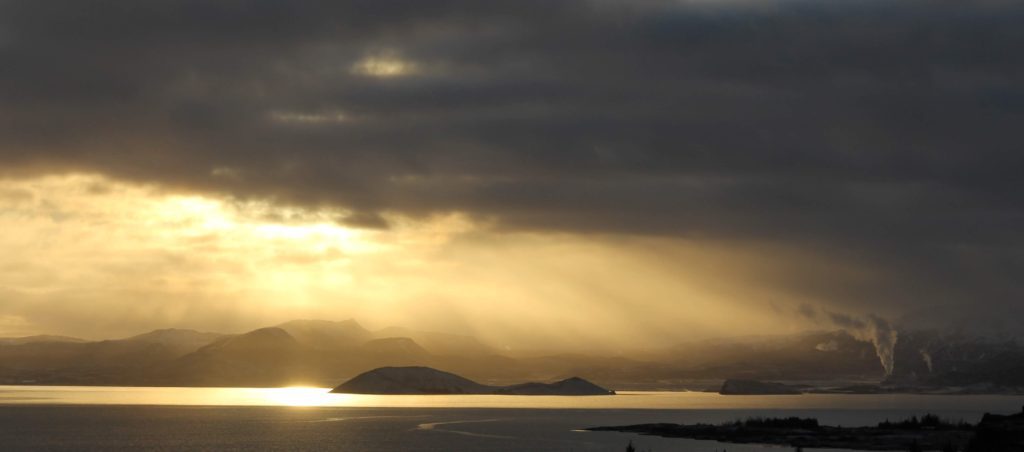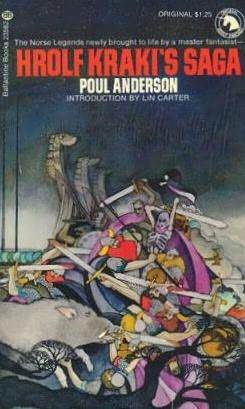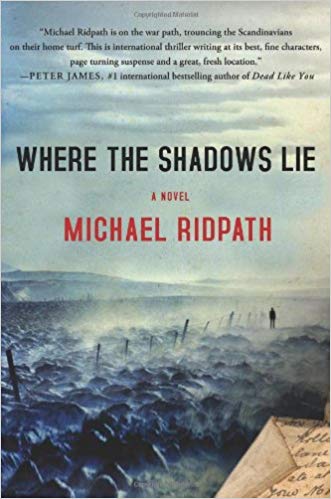Reading my way to Iceland

Pretty much since high school, I’ve had what W. H. Auden called “The Northern Thing”, a fascination with Vikings, Scandinavia, and their conflicting views on Fate (everything is predetermined) and Free Will (you must fight to death, and never give up, even as your fate is predetermined) (and do see Auden’s translation of the Elder Edda mentioned below!).
I’m not sure precisely where it started, but it was somewhere at the intersection of Tolkien, Dungeons & Dragons, and the teenage male fascination with death and destruction. That led to a college flirtation with becoming a medieval studies major (I read Old Norse and Old English for a brief time), before succumbing eventually (and probably for the better) to Mathematics and Computer Graphics.
This year I had a chance to travel to Iceland, the land of Fire and Ice, and the home of the medieval sagas I loved even as a teenager (ok I was kinda “not like the other kids”). Iceland also happens to be the home of Jolabokaflod, the “Yule Book Flood”, the tradition of giving books as gifts for Christmas. My kind of holiday (read about my trip here).
In preparation for my trip, I wanted to re-read some of my old favorites, as well as a new books that would give me context and re-kindle my interests in all things Norse. Myths, Sagas and some recent fiction, here’s what I read, plus a few promising books I found while I was there.
The Myths.
Snorri Sturluson is largely responsible for much of what we today think of as Norse mythology. Blond Valkyries carrying the fallen in battle to Valhalla, the one-eyed Odin and Thor’s Hammer. Sturluson wrote three of the northern world’s medieval masterpieces, the Prose (younger) Edda, the Heimskringla (the history of the Kings of Norway), and Egill’s Saga (one of the classic Icelandic sagas). (btw Egill was quite the asshole, see this hilarious recap on the Grapevine, a great Icelandic website). The Prose Edda is not to be confused with the Elder Edda, which, for maximal confusion, was NOT written by Sturluson. The Prose Edda, originally written as a treatise on poetry-writing (and to gain favor with a young King Hakon of Norway), is one of the main sources for much of what we know of Viking mythology, containing tales of Odin, Thor, Loki, and other gods.
Now, Sturluson, in addition to being a writer, was, as we might say today, an “operator”. Cunning, powerful, legalistic, and always looking out for himself. As you can imagine he did not come to a good end. All of this and more is captured in Nancy Marie Brown’s masterful Song of the Vikings, which tells Snorri’s tale alongside the Norse tales he captured (or created, your call).
The Elder Edda (not written by Snorri) contains a collection of mythical writings from old Norse mythology. My favorite is the Havamal, (“the sayings of the High One”), purported to be the pithy sayings of Odin. This is the home of cheery thoughts such as
“Praise not the day until evening has come, a woman until she is burnt, a sword until it is tried, a maiden until she is married, ice until it has been crossed, beer until it has been drunk.”
(In case you are wondering about that “burnt” bit, legend has it that the Vikings chieftains sometimes had their wives burned/buried/cremated along with them).
The Sagas

The sagas are the treasure of Icelandic literature. Written in the middle ages, most of the anonymously, they vary from mythological adventure stories to quasi-historical extended family sagas, and are sometimes referred to as the first prose (non-poetic) novels. Here’s a few of my favorites I (re-)read:
Hrolf Kraki’s Saga. A retelling/reconstruction by Poul Anderson. This is a classic grim Viking tale, “brothers to the death”, “defiance in the face of fate”, “blood & treasure” mythological saga. A bit hard to find these days, but look a bit online for a used copy. (And if you love this, go for Anderson’s The Broken Sword right afterwards).
Njal’s Saga is essentially Iceland’s Iliad. It tells the story of a spiraling series of conflicts that result in fifty year blood feud between Njal and various of his enemies. Like the Iliad, Njal’s saga can be quite gory (including Njal’s family being burnt alive in their house), and is something of a meditation on vengeance and its effects. It also offers insight into medieval Iceland’s byzantine legal system (one of the world’s first), and the workings of the Althing, the world’s first parliament, which occurred annually at Thingvellir, which we visited.

Grettir’s Saga. One of the last of the great Icelandic sagas. Grettir’s Saga is a mix of the historical (Grettir’s father escapes from Harald Fairhair, the King of Denmark), to the mythological/fantastic: Grettir’s doom is set when he fights the draugr (an undead zombie) Glam, who, as Grettir is killing him, curses Grettir to become unlucky and weak, which leads to his eventually becoming an outlaw, and to his death. Grettir’s saga has striking parallels with Beowulf, with Glam standing in for Grendel. Good fun, if you like that sort of thing.
(Note: you can read these sagas for free in Bookship!)
Modern Fiction with a Saga bent
Sometimes reading the old stuff can be a bit of a grind. So I mixed in some modern stuff, some of it with an historical/saga angle, some not.
One of Iceland’s more famous authors is Yrsa Sigurðardóttir. I read her Last Rituals, wherein a young German student with a dark interest in the Icelandic sagas and magic is found murdered, with strange symbols carved into him. A procedural murder mystery, I enjoyed it but found myself wanting a bit more depth in characters and in Icelandic backstory. Still I was reading in translation so some of that may be the translation. In this vein, but more enjoyable for me, was:

Where the Shadows Lie by Michael Ridpath. Boston, Iceland, Tolkien…pretty much hits all my highlights. A fun Icelandic romp. A Boston detective with Icelandic heritage heads to Iceland and ends up investigating a murder involving J.R.R. Tolkien and a lost Icelandic saga. My kind of book…
Also in a similar vein, although I did not get to it (yet!) is The Flatey Enigma by Arnar Ingolfsson.
Lastly I read some modern Icelandic fiction, without the saga backdrop. Sjón might be Iceland’s most famous writer, both for his works and for his collaborations with Björk. The Blue Fox is poetical fairy tale about a Reverend hunting a blue fox, intermixed in a tantalizing way with the story of an abandoned child, apparently with Down’s Syndrome. Lyrical, bleak and mysterious, it’s also a quick read.

Likely Iceland’s most commercially successful novelist is Arnaldur Indriðason, author of the Inspector Erlendur series, the first of which is Jar City. I re-read Silence of the Grave, the 2nd in the series - a brutal, yet fascinating mystery. It explores domestic violence, the tension between countryside and city Icelanders, between Icelanders and the British & Americans, and drugs and the dark side of Reykjavik. Of particular interest to me was the exploration of the post-WWII presence of the Americans and the tensions and grievances it created. (As an aside, and not meant as any insult, but Iceland is perhaps the most “Americanized” of the European countries I have been to, and I got a sense for how that might have happened from this book).
Books I found
Books are a big part of Icelandic culture (they are one of the most literate countries). And they have some great bookstores….and yet… books are $%!@ expensive in Iceland. A small paperback usually runs about $26! So, haunting a few bookstores, I found some really interesting books….that I decided to get when I was back in the states. :).

Smile of the Wolf looks really interesting. Essentially a modern fiction novel wrapped in the skin of a medieval Icelandic saga. Fish Have No Feet, from Booker International nominated Jon Kalman Steffanson, offers a unique insight into modern Iceland and the ways in which it has been shaped by outside influences. If you want some dark humor and Icelandic slacker culture in a modern setting, try 101 Reykjavik (the name of this book, as well as the main area of Reykjavik, as well as a movie made from the book). Be warned: it sounds like it’s not for everyone.
But Iceland is! Everyone seems to speak English there, so (assuming you speak English), it’s an easy place to visit, and it has a rich literary history as well as a rich actual history. Enjoy!
(P.S. In between starting and finishing this post, I read the first few chapters of Smile of the Wolf. Wow. If anything I wrote here sounds interesting to you, start with Smile of the Wolf. Bracing like a shot of the “Black Death” the Icelanders are found of drinking.)


